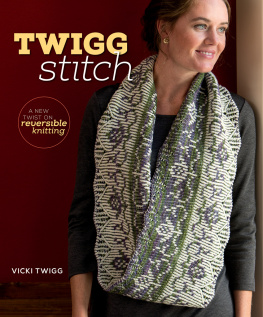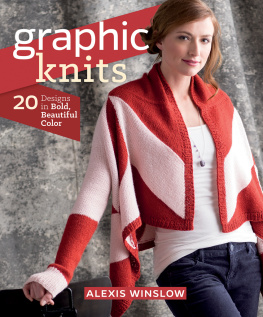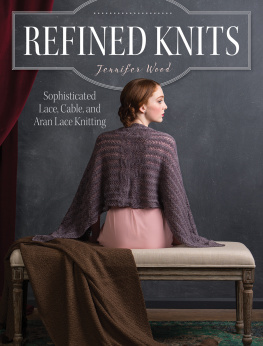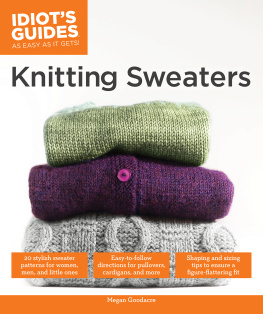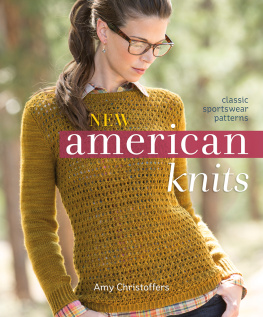
DEDICATION
This book is dedicated to my mum and dad
for always encouraging me!
Models: Joseph Johns and Cara Louise Partridge
Photographer: Tony Long
Copyright
Copyright 2017 by Jody Long
All rights reserved.
Bibliographical Note
Contemporary Cables: Classic Aran Reimagined in Current Styles is a new work,
first published by Dover Publications, Inc., in 2017.
International Standard Book Number
ISBN-13: 978-0-486-80527-6
ISBN-10: 0-486-80527-1
Manufactured in the United States by LSC Communications
80527101 2017
www.doverpublications.com
ACKNOWLEDGMENTS
I would like to say a big thank you to all of the following:
To my wonderful commissioning editor Katharine Maller, for allowing me
to write this book, and to Vanessa Putt, my new editor, who kept me on
my toes and helped me to finish this book.
To my dad, Tony Long, for art directing and taking the photos.
To the fabulous models, Joseph Johns and Cara Louise Partridge, who no
doubt will never forget the photo shoot, as we all battled the cold sea air
and carried on regardless of what Mother Nature threw at us that day!
To my fantastic knitters, Karen Evans, Rita Taylor, Susan Winn, Tina Miller,
Josephine Lockwood, Marcy Spavins, Rachel Wiseman, Linda Barker, and
Hetty Williams.

INTRODUCTION
I love cables. This life-long affair began when I learned
to cable knit at the age of twelve. I was completely
fascinated by making twists and turns going in all
directions in the knitted fabric. I never thought that
several years later I would find myself designing my own
cables and using traditional ones to design the garments
in this book.
Cables look more difficult than they actually are. To knit
a cable you simply slip stitches onto a cable needle, hold
them at the front or back of the work, knit or purl stitches
from the left-hand needle, then work the stitches off the
cable needle. Its as simple as that! You will find a wide
range of modern and fresh knitting ideas in this book.
And you can rest assured that all the pattern instructions
have been tried out by a professional knitter. I wish you a
lot of fun knitting your favorite items from this book!
HOW TO SUBSTITUTE YARNS
Throughout this book several different brands and
weights of yarn have been used. It is extremely simple to
find a substitute yarn by using this simple math equation.
If the garment you are going to knit takes 7 x 3.5oz/100g
balls of yarn, which has a yardage of 322yds/295m and
your new substitute yarn has a yardage of 197yds, you
will need to divide the recommended yarn length total
by the new yarn length of 197 to get the number of balls
required.
For example: 7 x 322yds = 2,254yds needed (recom-
mended). 2,254yds divided by the new yardage, which is
197yds = 11.44, so you will need 12 x 3.5oz (100g) balls
to complete your garment using the new yarn.
I recommend always substituting with the same or a
similar weight yarn, otherwise you might encounter
problems. Always knit a gauge swatch in the new yarn to
match the stated gauge in the pattern.
AMOUNT OF YARN
Yarn amounts specified in the patterns can never be
absolutely correct. This is partly due to the fact that
tensions vary according to the knitter, but mostly
because the number of yards/meters per ounce/gram
varies with every color of yarn. To ensure that you will not
run out of yarn, the yarn amounts given in the patterns
are generous.
EQUIPMENT
Sewing needle: Always use a wool (knitters) sewing
needle for sewing, as these tend to be blunt and will not
split the yarn fiber or stitches, making a neater seam.
Stitch holders: These prevent stitches from unraveling
when not in use. Alternately, a spare knitting needle of
the same size or less (ideally a double-pointed needle)
can be used as a stitch holder. For holding just a few
stitches, a safety pin is always useful.
Cable needle: There are two types of cable needles,
one with a kink and the other one is straight, similar to a
double-pointed needle. I recommend the one with the
kink as this keeps the stitches from sliding off the needle.
GAUGE
It is important to check your gauge before you start
knitting. Knit a swatch using the specified yarn and
knitting needles. If there are too many stitches to your
4in/10cm sample, your tension is tight and you should
change to a larger-sized needle. If there are too few
stitches, your tension is loose and you should change to
a smaller-sized needle.

CASTING ON (Cable Method)
Although there are many different techniques for casting
on stitches, the following method creates a firm and
attractive edge:
First make a slip knot in the yarn and place the loop on
the left-hand needle. Insert the point of the right-hand
needle into the loop on the left-hand needle, wrap the
yarn around the right-hand needle and draw the yarn
through the loop. Pass the new loop onto the left-hand
needle and pull the yarn to tighten the new loop.
Next insert the right-hand needle between the two
loops on the left-hand needle, wrap the yarn around the
right-hand needle and draw the yarn through. Slip the
new loop onto the left-hand needle as before.
Continue in this way, inserting the needle between two
loops on the left-hand needle, until you have the
required number of stitches.
BASIC STITCHES
Here is how to work the simple stitches used for the


